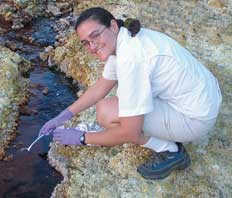| |

April 2004, Vol. 13, No. 4 | Return to Table of Contents
New Center for Oceans and Human Health Established in Woods Hole
Scientists in the MBL's Josephine Bay Paul Center for Comparative Molecular Biology and Evolution have joined together with researchers from WHOI and MIT to form the Woods Hole Center for Oceans and Human Health (COHH). The new Center will serve as a focal point for research on issues at the intersection of oceanographic, biological, and environmental health sciences, such as harmful algal blooms and organisms in coastal waters and estuaries that cause human illness and death.
The Woods Hole Center and three others being established around the country are the first in a new collaboration between the National Institute of Environmental Health Sciences, one of the National Institutes of Health, and the National Science Foundation. The two agencies are providing approximately $6.25 million over the next five years to establish the Woods Hole COHH and to fund projects by a large number of investigators, students, and scholars. John Stegemann, a senior scientist in the WHOI Biology Department, will serve as the Center's Director.
 |
|
MBL Staff Scientist Linda Amaral Zettler is working on one of the first four research projects funded by the Center. She and her colleague Rebecca Gast of WHOI will be investigating the distribution and abundance of particular human pathogens, including Giardia, Cryptosporidium, and Vibrio, in Mount Hope Bay which is located in the northeast arm of Narragansett Bay. By combining observations of the physical and chemical environment with information on the biological distribution of the pathogens in the Bay, Amaral Zettler and Gast hope to build and validate a three-dimensional water quality/eutrophication model that could be used to predict where and when pathogens might be found in this significantly polluted estuarine environment. "Little is known about the occurrence, much less the prevalence and distribution, of traditionally non-marine human pathogens," says Amaral Zettler. "The contamination of coastal and estuarine areas through freshwater runoff, sewage and thermal pollution will influence the distribution, survival and persistence of human pathogens in marine environments. Since we as a society depend heavily on the marine environment for food, recreation and other resources, it is important to understand the factors that might threaten these resources."
Amaral Zettler's and many of the other COHH projects will take advantage of the genomics facility housed in the MBL's Bay Paul Center. Bay Paul Center Director Mitchell Sogin will direct the COHH's Genomics Facility Core, which will enable researchers to do high-volume DNA sequencing and analysis. In addition, Stephen Hajduk, Director of the MBL's Global Infectious Diseases Program, will head up the COHH's Pilot Program whose aim is to solicit and review applications for new COHH grants. All faculty and research scientists from MBL, WHOI, and MIT are eligible to apply for Pilot Project grants.
|